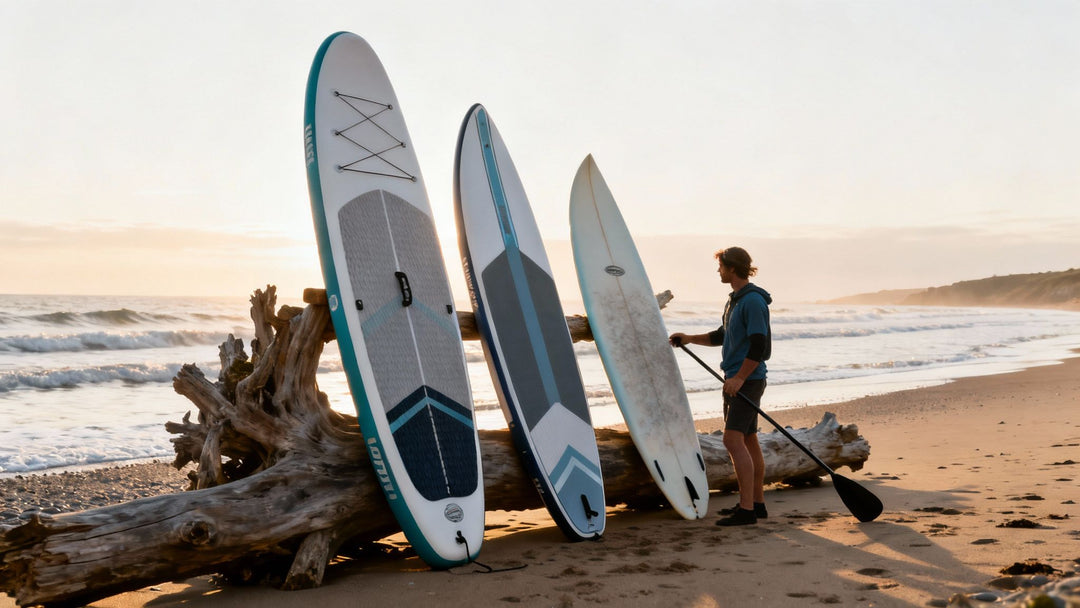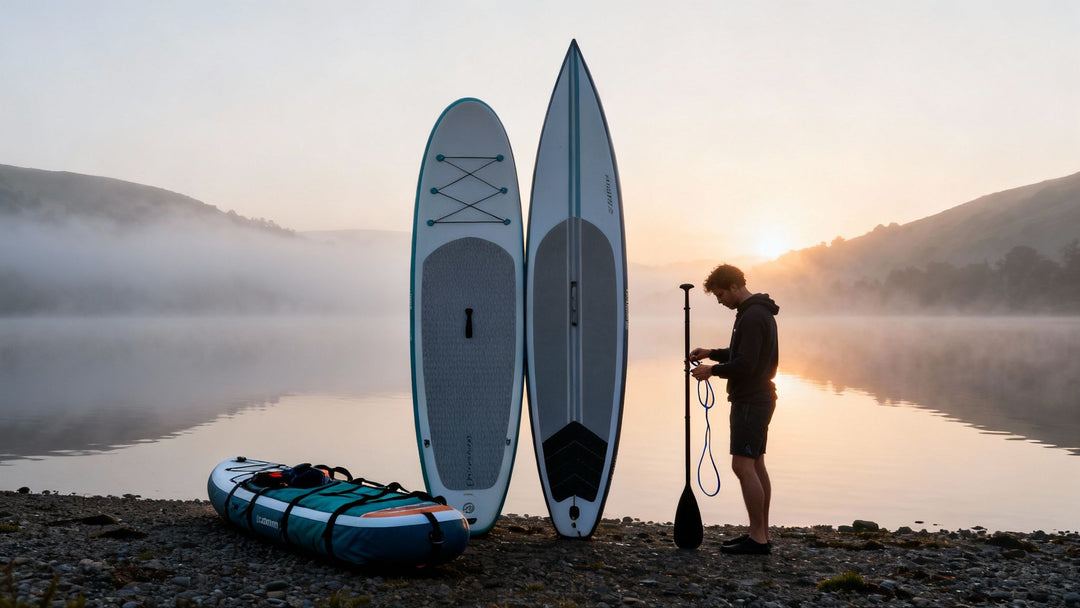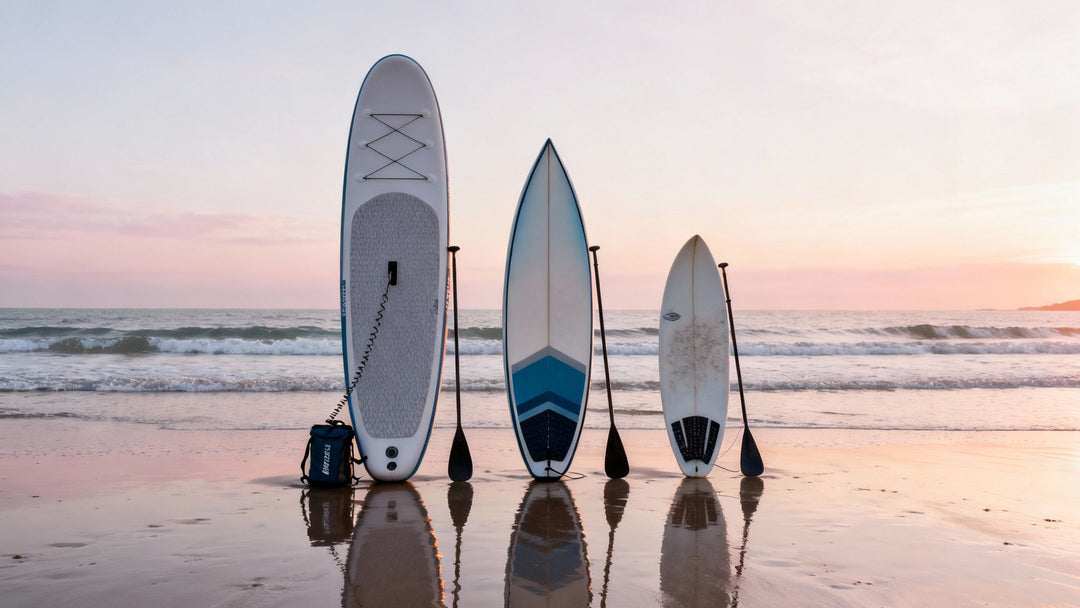How to Choose a SUP Board a UK Paddler's Guide
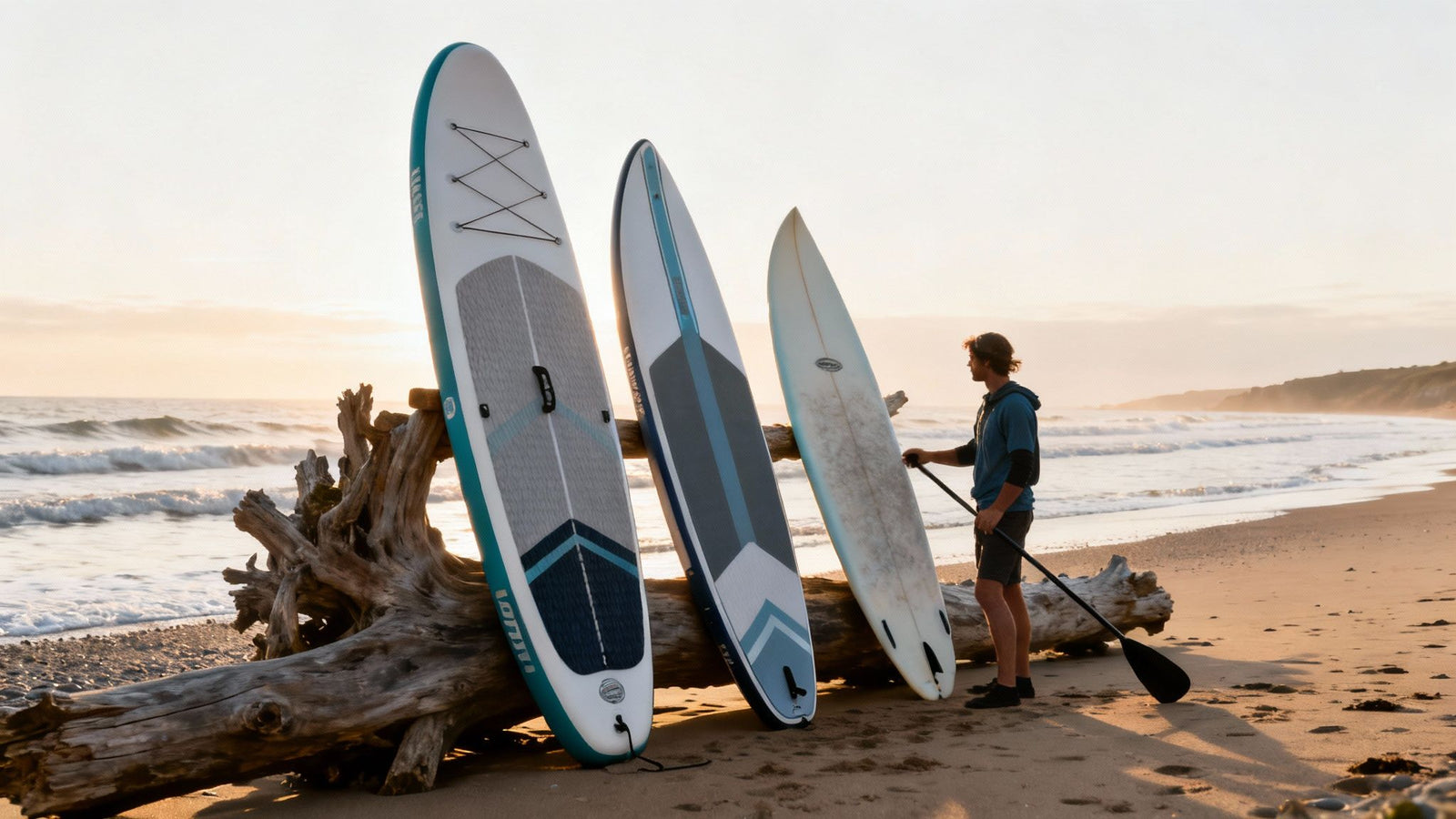
So, you’re ready to dive into the wonderful world of stand-up paddleboarding. Fantastic choice! From the serene lochs of Scotland to the sun-drenched Cornish coast, more and more people across the UK are discovering the unique buzz of gliding across the water.
But let's be honest, figuring out how to choose a SUP board can feel like a minefield. Get it right, and you’ve got a ticket to countless adventures. Get it wrong, and you're in for a wobbly, frustrating time. Don’t worry, I’m here to make sure that doesn't happen.
Your first and most important decision is matching the board's type—generally All-Round, Touring, or Surf—to what you actually plan to do. This single choice will dictate your stability, speed, and how much fun you have out there. For example, trying to paddle down a long, straight canal on a short, tippy surf SUP would be exhausting, just as taking a narrow touring board into the waves at Fistral Beach would be a recipe for a swim.
To make things a bit clearer, this decision tree gives you a quick visual rundown to help you pick a board based on your plans, whether that's a chilled-out paddle or a proper long-distance journey.
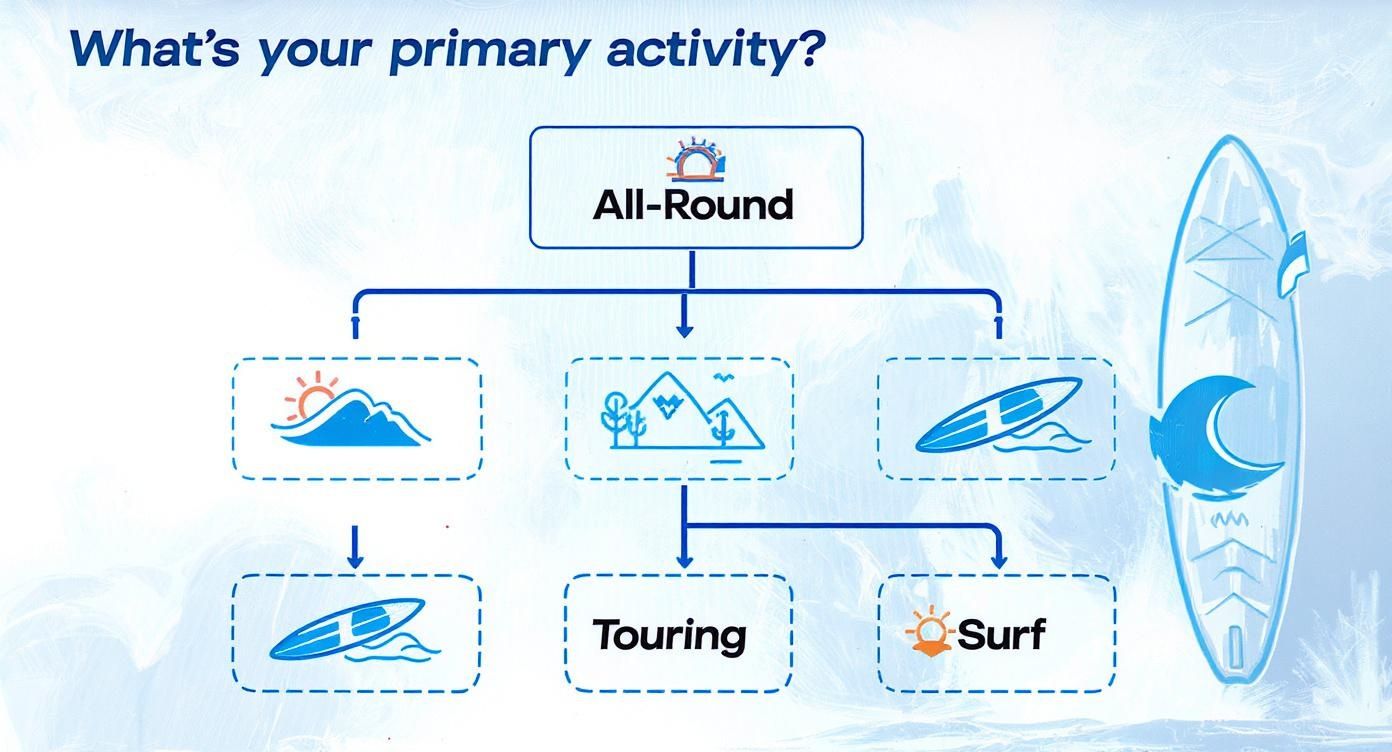
As you can see, what you want to do is the key to narrowing down your options.
Understanding the Main SUP Categories
Let's break down the main types of paddle boards you'll come across. Each one is shaped and built for a specific job, and knowing the difference is the first real step to finding your perfect paddling partner.
- All-Round Boards: Think of these as the versatile Swiss Army knives of the SUP world. They’re typically wider and thicker, which means brilliant stability. This makes them perfect for beginners, families, or anyone who wants one board for a bit of everything—gentle paddling on a local lake, SUP yoga, or even taking the dog along for a ride. A practical example is the Amigo Air, which is designed to be a fantastic starting point for most newcomers.
- Touring Boards: Built for covering distance with ease. Touring boards have a pointed nose (what we call a displacement hull) that slices through the water, helping you paddle faster and stay in a straight line. If you're planning longer expeditions, like a multi-day trip down the River Wye or a coastal exploration in Pembrokeshire, a board like the Motion Air is the right tool for the job.
- Surf SUPs: These are shorter, narrower, and have more rocker (that’s the upward curve from nose to tail). They’re designed purely for manoeuvrability on waves. On flat water, they feel much less stable and are definitely better suited for experienced paddlers looking to catch some surf at spots like Saunton Sands. A performance example is our El Diablo Hard SUP.
- Race Boards: The Formula 1 cars of paddleboarding. These are the narrowest and longest boards, built for one thing: speed. They are incredibly tippy and are really only for competitive racing.
The global SUP market is now valued at around USD 1.9 billion, and the UK is a huge part of that scene. Inflatable SUPs are king over here, mainly because they’re so easy to transport and store, which fits perfectly with the urban lifestyle many UK paddlers have.
Because our waterways are so diverse, the all-round models remain the most popular choice by a country mile. If you want to geek out on the numbers, you can explore more market trends in this detailed stand-up paddleboard market report.
To help you visualise this, I've put together a quick reference table matching common UK paddler profiles to the ideal board.
Quick SUP Choice Reference Guide
| Paddler Profile | Primary Use | Recommended Board Type | Example Loco Board |
|---|---|---|---|
| The Weekend Explorer | Casual paddling on lakes, canals, and calm coastal bays | All-Round | Amigo Air |
| The Family Paddler | Fun with kids and pets, beach days, short trips | All-Round (larger volume) | Amigo Air 10'6'' |
| The Adventure Seeker | Long-distance paddles, multi-hour journeys, river trekking | Touring | Motion Air |
| The Coastal Waverider | Catching small to medium-sized UK waves | Surf SUP | El Diablo Hard SUP |
Hopefully, this gives you a much clearer idea of where to start your search. The right board is out there, and finding it is the first step on an amazing journey.
How SUP Board Shapes Affect Performance
The single biggest factor in how a paddle board feels and moves on the water is its shape. Think of it like choosing a bike: a skinny-tyred road bike is built for pure speed on tarmac, while a mountain bike with chunky tyres is all about stability on rough trails. SUPs are no different.
Getting your head around the core design elements—the nose, tail, and overall outline—is the key to choosing a board that actually fits what you want to do. A board's shape, what we often call its "plan shape," dictates its glide, stability, and how easily it turns. Even tiny variations can completely change the experience.
Let's break down the common shapes you'll come across.
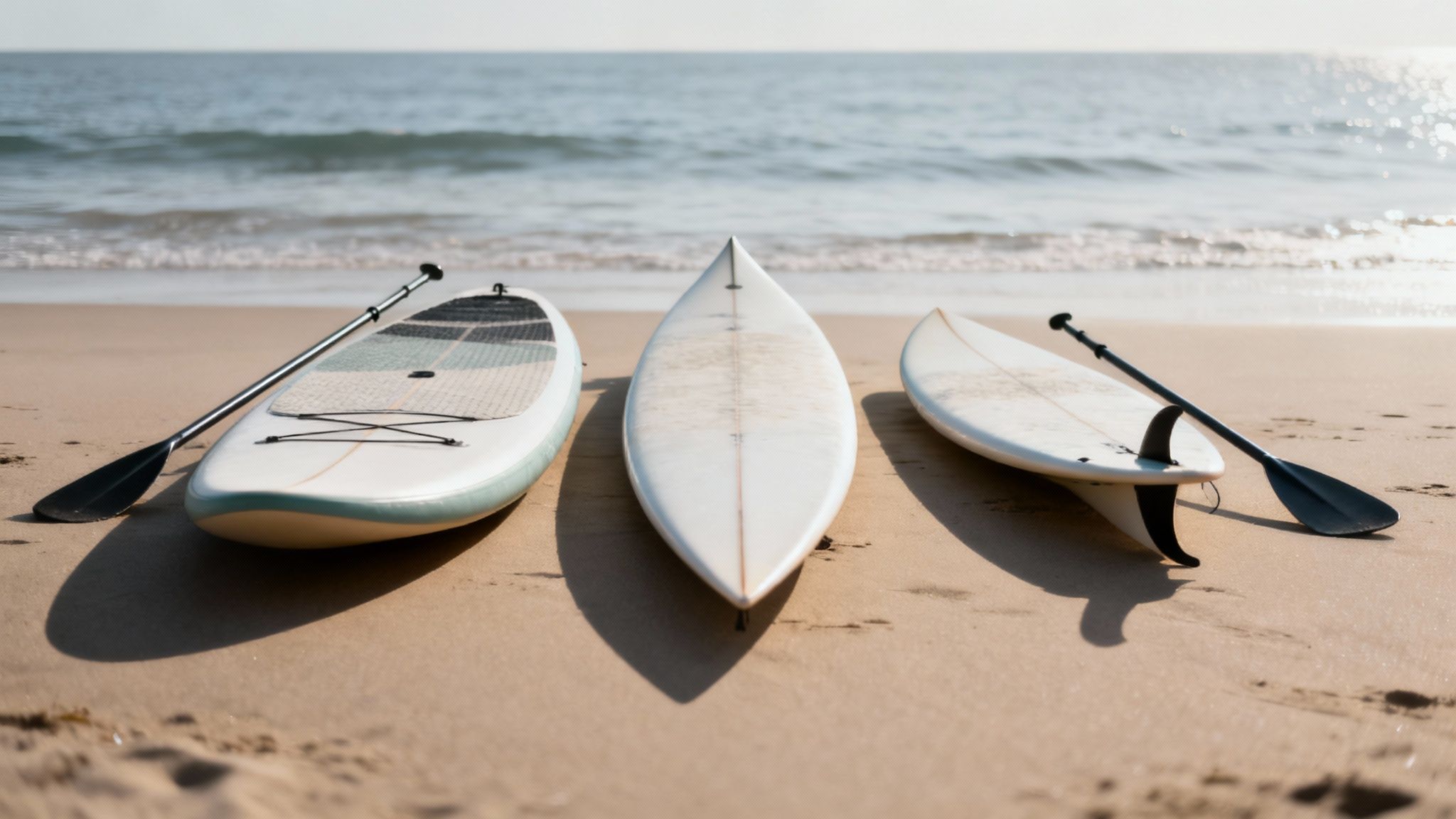
All-Round Shapes: The Versatile Option
All-round boards are the most popular choice, and for good reason. They have a wide, rounded nose and a fairly wide tail, which creates a stable and forgiving platform. This design is perfect for beginners and anyone wanting one board to do a bit of everything.
Picture a family day out at a calm lake in the Lake District. An all-round board like the Loco Amigo Air is the perfect tool for the job. Its generous width gives a nervous first-timer the confidence to stand up, while the rounded nose helps it ride over small chop rather than ploughing through it. Later, the kids can jump on and off without the whole thing feeling hopelessly tippy.
The versatility of an all-round shape cannot be overstated. It's the go-to design for SUP yoga, fishing, or paddling with a dog on board precisely because its primary focus is on providing a steady, reliable base.
Touring Shapes: For Speed and Efficiency
In contrast, touring boards are built to cover distance. They have a very obvious pointed nose, known as a displacement hull, designed to slice through the water efficiently, much like the bow of a kayak. This shape dramatically cuts down on drag and helps the board track in a straight line with far less effort.
Now imagine you're planning a multi-hour coastal trip along the Jurassic Coast. This is where a touring board like the Loco Motion Air shines. Its length and pointed nose let you keep up a higher average speed and paddle for longer before you feel knackered. When the wind picks up, that displacement hull cuts through the waves, giving you a much smoother ride than the bumpy, slapping feeling you'd get on a round-nosed board.
Here’s a quick look at how these two shapes stack up in the real world:
| Feature | All-Round Shape (e.g., Loco Amigo Air) | Touring Shape (e.g., Loco Motion Air) |
|---|---|---|
| Primary Goal | Stability and versatility for various activities. | Speed and efficiency for long-distance paddling. |
| Nose Shape | Wide and rounded (planing hull). | Pointed and sharp (displacement hull). |
| Best For | Beginners, families, SUP yoga, calm water. | Intermediate to advanced paddlers, long tours, choppy water. |
| Feel on Water | Sits on top of the water; very stable but slower. | Cuts through the water; faster and tracks straighter. |
Surf and Hybrid Shapes: For Agility
Finally, you get into more specialised shapes, especially for SUP surfing. Surf SUPs are much shorter, have a narrower tail, and more "rocker" (the curve from nose to tail). This is what makes them incredibly nimble for whipping around on a wave.
A dedicated surf model like the Loco El Diablo Hard SUP, for instance, is built to carve turns on a wave face at a spot like Fistral Beach. But take it on flat water, and its specialised shape makes it incredibly wobbly and unstable. It’s a perfect example of design following function.
For many paddlers who aren't pure surfers, a great middle ground is a versatile all-rounder that can still handle small waves. If you're trying to find that perfect balance, the experts at Northwest Paddleboarding have some excellent guidance on matching board types to your goals.
Ultimately, choosing the right shape comes down to being honest about where and how you'll paddle most often. An all-rounder offers freedom and fun for casual days out, while a tourer unlocks longer, more ambitious adventures.
Choosing the Right SUP Size and Volume
Once you’ve settled on the general shape of your board, it’s time to get into the numbers that really define how it will feel on the water: length, width, and volume. Don't let the specs intimidate you; think of them as the recipe for your perfect ride. Getting these right is your ticket to confidence and fun.
Get the size wrong, and you're in for a frustrating time. A practical example: a 90kg person trying to learn on a low-volume, 180L board will find it sinks too low in the water, making it feel incredibly tippy and almost impossible to stand on. On the other hand, a 60kg person on a huge 340L board might feel stable, but will struggle to turn it, feeling like they're trying to steer a barge.
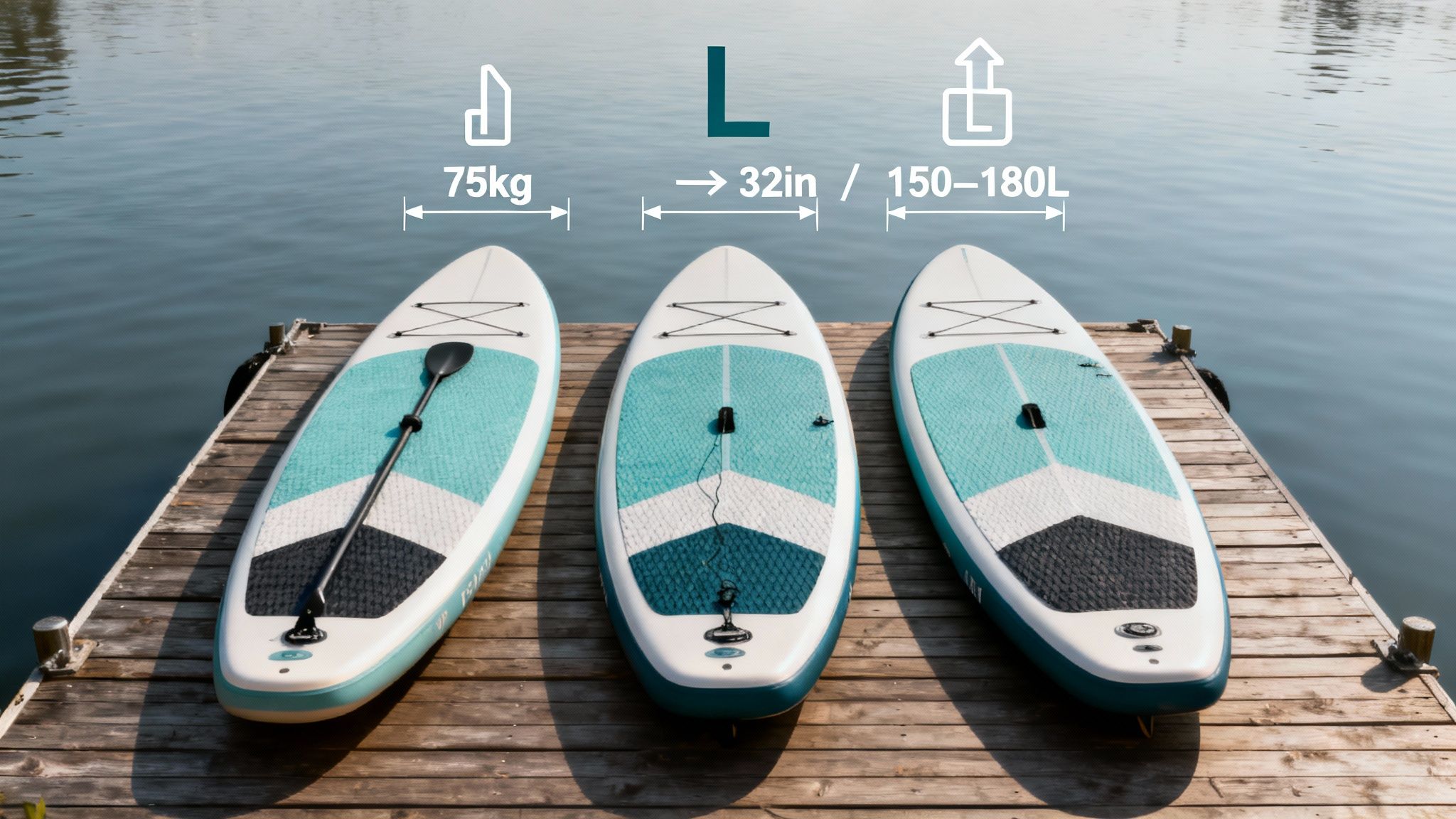
Decoding Board Volume
Let's start with the most important number of all: volume. Measured in litres (L), volume is a direct measure of a board's ability to float. It tells you exactly how much weight it can support while staying stable and buoyant. Simply put, more volume equals more float, which is absolutely essential for beginners and heavier paddlers.
As a basic rule, one litre of volume displaces one kilogram of water. So, a board with 250L of volume can float 250kg of weight before it even thinks about sinking. Of course, you need a lot more volume than just your body weight to create a stable platform you can actually stand on.
For a stable, all-round experience, a great starting point is to look for a board with a volume in litres that is roughly double your weight in kilograms. For instance, an 80kg paddler should be looking for a board with at least 160L of volume, but would likely feel more comfortable on something over 240L, like the Loco Amigo Air.
This simple calculation gives you a solid baseline, but your skill level also comes into play. A seasoned paddler with refined balance can get away with a much lower volume board compared to someone just starting out.
The Role of Width and Length
With a target volume in mind, you can now look at the board's width and length. These two dimensions work together to shape the board's personality and performance on the water.
- Width for Stability: This is the key dimension for feeling secure, especially as a beginner. Wider boards (32 inches or more) create a much more solid platform, making balancing a breeze. A 75kg beginner will feel worlds more confident on a 32-inch wide board like the Amigo Air 10'6'' than a 30-inch one. That extra width is also a game-changer for things like SUP yoga or if you plan on bringing a child or a dog along for the ride.
- Length for Speed and Tracking: Longer boards are generally faster and track better, meaning they hold a straight line more easily. A touring board, often 11 feet or longer like the Loco Motion Air, will glide effortlessly across the water. In contrast, a shorter board (under 10 feet) is much more nimble and easier to turn—perfect for SUP surfing but not ideal for a long-distance paddle.
It’s no surprise that UK schools and rental shops often point beginners towards boards around 10 to 11 feet long and 30 to 32 inches wide. For a paddler weighing between 60 to 80 kg, a volume of about 120 to 160 litres is the sweet spot for buoyancy. This reflects a clear trend, with over 60% of UK buyers prioritising stability and beginner-friendly features above all else.
SUP Sizing Guide by Paddler Weight and Skill Level
To pull all this information together, here’s a handy guide that matches paddler weight and skill level to the ideal board dimensions. Use this table to help narrow down your options when you’re browsing specific models.
| Paddler Weight (kg) | Skill Level | Recommended Width (inches) | Recommended Volume (Litres) |
|---|---|---|---|
| Under 60kg | Beginner | 30" - 32" | 170 - 220L |
| Intermediate | 28" - 30" | 140 - 180L | |
| 60kg - 80kg | Beginner | 32" - 34" | 220 - 260L |
| Intermediate | 30" - 32" | 180 - 230L | |
| 80kg - 100kg | Beginner | 33" - 35" | 250 - 300L |
| Intermediate | 32" - 34" | 220 - 270L | |
| Over 100kg | Beginner | 34" - 36" | 280 - 340L+ |
| Intermediate | 33" - 35" | 260 - 320L+ |
Just remember, this is a starting point. If you plan to carry extra gear like a cool box or camping kit, you’ll need to add that weight to your calculations. When in doubt, it’s always better to go for a board with a bit more volume than you think you need. A little extra stability is far more forgiving for a newcomer than not having enough.
For a deeper dive into finding your perfect match, check out our comprehensive SUP board size guide for more tailored advice.
Inflatable vs Hard Board: What's Best for You?
Deciding between an inflatable stand-up paddleboard (iSUP) and a traditional hard board is one of the biggest choices you'll make. This isn't just about convenience; it's about matching the board's construction to your lifestyle, storage space, and paddling ambitions. Let's get into the real-world differences.
The debate used to be simple: hard boards for performance, inflatables for portability. But technology has moved on. Modern iSUPs aren't the pool toys of yesteryear; they are serious bits of kit built for proper adventures.
The Case for Inflatable SUPs
For the vast majority of UK paddlers, an inflatable board is simply the most practical choice. If you live in a flat, have limited garage space, or don't fancy the faff of a roof rack, an iSUP is your best friend. They pack down into a large rucksack, fitting easily into a car boot or a cupboard at home.
A practical example: imagine being an urban explorer in Manchester who loves hitting different waterways. One weekend you're on the canals, the next you're driving to the Lake District. An iSUP like the Loco Amigo Air makes this spontaneity possible – just throw it in the car and go.
Beyond portability, high-quality inflatables offer incredible durability. Made from military-grade PVC and advanced drop-stitch technology, they can handle bumps against rocks, canal locks, or being dropped on the ground far better than a precious hard board. This makes them a fantastic option for families with kids or anyone paddling in rocky, shallow rivers.
Premium iSUPs from brands like Loco use advanced construction to deliver surprising rigidity. When inflated to the correct pressure (usually around 15-20 PSI), they feel incredibly stiff underfoot, challenging the performance gap between them and their solid counterparts.
When a Hard Board Is the Right Choice
While inflatables have come a long way, hard boards still hold the edge in pure performance. Constructed from materials like epoxy, fibreglass, and carbon fibre over a foam core, they offer a level of responsiveness that an iSUP can't quite match.
This direct connection to the water results in superior glide and speed. A hard board cuts through the water with minimal flex, meaning more of your paddle stroke's power is converted into forward motion. That efficiency is a game-changer for serious touring or racing.
Where hard boards truly excel is in the surf. Their rigid rails allow you to carve and turn on a wave with a precision that inflatables struggle to replicate. If you're a coastal local in Cornwall dreaming of catching waves at your home break, a hard board is the undisputed winner. A model like the El Diablo Hard SUP is specifically designed for this, offering the control needed for performance SUP surfing.
Making the Decision: Practical Scenarios
Let's look at how this choice plays out for different types of paddlers.
- The Urban Paddler with No Car: You live in a city-centre flat and rely on public transport. An iSUP in its backpack, like the Loco Amigo Air, is your only realistic option to get to the water.
- The Family with Young Kids: Durability is key. An inflatable board can withstand being dragged across a shingle beach and used as a diving platform without you stressing about dings and scratches.
- The Aspiring SUP Surfer: You live near the coast and want to progress in the waves. A hard board like the Loco El Diablo will offer the performance you need to sharpen your skills.
- The Long-Distance Tourer: You prioritise efficiency over thousands of paddle strokes. The superior glide of a hard touring board will make your long journeys faster and less tiring.
Ultimately, the choice comes down to a simple trade-off between convenience and peak performance. For most recreational paddlers in the UK, the practicality and robustness of a quality inflatable make it the smarter investment.
If you want to dig even deeper into the specifics, our detailed inflatable paddle board buyer's guide breaks down the technology even further.
Budgeting for Your Board and Essential Gear
Think of a paddle board not as a single purchase, but as a complete kit designed to keep you safe and having fun on the water. It’s tempting to just look at the price of the board, but factoring in the paddle, pump, and safety gear from the start will save you a lot of hassle and money down the line.
Let's break down what you can expect at different price points, so you can see where your money goes and what you get for it. A complete board and paddle combo can start from around £200 and go all the way up to £1,200 or more for a top-tier setup.
A quality paddle, especially a carbon or fibreglass one, makes a huge difference in how efficiently you move through the water. And whatever you do, don't skimp on safety gear like a buoyancy aid and a reliable leash.
Entry-Level Boards
In the £200 to £350 bracket, you'll find plenty of inflatable SUPs that offer a great way to get started without a massive investment. This is where most people test the waters, so to speak.
These packages usually come with a basic aluminium paddle, a simple pump, and a standard carry bag. They'll get you on the water and having fun, but you might notice they flex a bit in choppy conditions and don't track in a straight line as well as more expensive boards.
A practical example of a standout in this category is the Loco Amigo Air kit. Even at an accessible price, it uses a more robust dual-layer PVC construction that feels much more rigid underfoot compared to the flimsy single-layer boards often found on generic marketplaces.
"Spending a little more up front often saves money on upgrades later,” says Joe, founder of Loco Surfing.
Mid-Range Options
Once you move into the £400 to £600 range, you'll start to see some significant improvements in performance and materials. Boards in this category often feature better drop-stitch technology and come bundled with lighter carbon-blend paddles.
What you’ll notice straight away is:
- A much stiffer board, especially in flat water conditions.
- They inflate quicker and hold a higher pressure, typically 15–20 PSI, for maximum rigidity.
- The deck pads are often upgraded for better grip and comfort during longer paddles.
| Tier | Price Range | Key Features | Example Loco Product |
|---|---|---|---|
| Entry Level | £200–£350 | Aluminium paddle, basic pump, single-layer PVC | Amigo Air |
| Mid Range | £400–£600 | Carbon paddle, dual-layer build, EVA pad | Amigo Air Deluxe Package |
| Premium | £700+ | Full carbon paddle, premium drop-stitch, extras | Motion Air Package |
Mid-range boards from reputable brands often provide the best value. Loco’s Amigo Air Deluxe package, for instance, includes a carbon paddleshaft and a high-capacity pump, so you won't feel like you're stuck with beginner gear that you'll want to replace in a few months.
Premium Packages
If you're serious about paddle boarding and ready to commit, the £700+ tier is where the experience gets completely transformed. These premium kits come loaded with high-end accessories like proper travel backpacks with internal frames, coiled leashes, and specialised PFDs.
A great example is the Loco Motion Air + Carbon Paddle package. This isn't just a board; it's a complete touring setup with a 2-piece carbon paddle, a high-volume pump, a bespoke leash, and even a robust dry bag.
Getting the right paddle is a big part of this. You might find our guide on Selecting the Perfect SUP Paddle really helpful.
Thinking about the little extras from the beginning also helps:
- Dry Bag: Keeps your phone, keys, and snacks safe. Usually around £20.
- Deck Bag: For easy access to tools or drinks.
- Rail Guards: A must-have to prevent dings on hard boards.
Buying a complete, well-thought-out package from the start means no hidden costs or the frustrating realisation that you need to upgrade your gear after just a few sessions.
Must-Have Safety Gear
Some items are simply non-negotiable for staying safe. Make sure you invest in a good buoyancy aid, a coiled leash, and a pump that can reliably hit that 15–20 PSI mark. For more information on staying safe on the water, the RNLI's SUP safety guide is an essential resource.
- An inflatable PFD belt (around £50) offers great freedom of movement.
- A coiled leash is much better than a straight one as it stays on the board and reduces the risk of snagging on anything underwater.
- A high-pressure pump with a built-in gauge is essential for getting your inflatable board to the right stiffness.
Good kits, like those from Loco, bundle these essentials in, which means you spend less time shopping around and more time actually paddling. Ultimately, building your kit with quality gear from the outset ensures you'll be paddling longer, safer, and with a bigger smile on your face.
Still Got Questions? Let's Clear Things Up
Even after you've weighed up all the options, a few last-minute questions can often pop into your head. Getting these sorted is the final piece of the puzzle, making sure you feel 100% confident in your choice. We get asked these all the time, so here are some straight-talking answers to the most common queries from paddlers.
Do I Actually Need Fins? What Are the Different Types?
In a word: yes. Fins are non-negotiable. Without them, your board would just spin in circles, making it utterly impossible to paddle in a straight line. They’re like the keel on a boat, giving you tracking (the ability to go straight) and control.
Most all-round boards, including the Loco Amigo Air range, come with a versatile ‘thruster’ setup. This means you get one larger fin in the centre and two smaller side fins, sometimes called 'side bites'. This combination strikes a great balance between straight-line speed and manoeuvrability, making it a brilliant do-it-all option for most conditions.
On the other hand, a touring board like the Loco Motion Air is designed for covering distance, so it typically uses just a single, larger fin. This setup cuts down on drag and really boosts your tracking, helping you paddle further with less effort. Some boards also come with interchangeable fin boxes, which is a fantastic feature. A practical example is swapping to a shorter river fin to avoid catching on rocks when paddling in the shallows of the River Dart.
What's the Best Board for Paddling with a Dog or Child?
Taking a passenger along for the ride is fantastic fun, but it calls for one thing above all else: stability. The secret to a stable, wobble-free paddle is picking a board with plenty of width and volume.
You'll want to be looking at a wide, all-round board that's at least 32 inches across, although 33-34 inches is even better. That extra width creates a really solid platform that won’t feel tippy when your child or dog inevitably starts fidgeting.
Just as important is having enough volume to comfortably support the combined weight. A board like our Loco Amigo Air 10'6'' is a superb choice here. It’s got all the volume you need and a huge, non-slip EVA deck pad that covers most of the board. This gives your furry friend’s paws or a child’s feet plenty of grip and comfort, helping them feel secure.
When you're paddling with pets, durability is also a must. The robust, multi-layer PVC used in quality inflatable SUPs can easily handle a few claws, so you don’t need to stress about punctures.
Is a More Expensive SUP Really Worth the Money?
Honestly? In almost every case, yes. While a super-cheap board from a big online marketplace might get you on the water for £200, you're investing in so much more than just a brand name when you step up to a £450+ board from a specialist brand like Loco. A higher price tag means better materials, smarter construction, and a much more thoughtful design.
For an inflatable SUP, this makes a huge difference:
- It’ll be way more rigid. Premium boards use advanced drop-stitch technology and fusion-laminated PVC, making them incredibly stiff once inflated. This stops the board from sagging in the middle like a banana (a classic problem with cheap boards) and makes paddling feel so much better.
- It's built to last. Higher-quality materials and construction mean the board will see you through many seasons, resisting punctures and dodgy seams.
- It’s often lighter. Better tech often means a board that is both stronger and lighter, which you'll definitely appreciate when you're carrying it down to the beach.
A quality board from a dedicated SUP brand like Loco won't just perform better; it will also hold its value and last you for years. It’s a much smarter long-term investment than buying a cheap board you’ll probably have to replace after just a season or two.
Ready to find the perfect board with advice you can trust? The team at Loco Surfing has been designing and riding boards here in the UK for over a decade. Come and explore our full range of expertly crafted SUPs and find your ideal match today.


